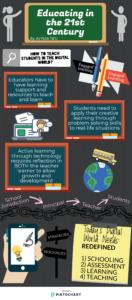After looking through the Technologist Module that is offered through Ontario Extend, I am now reflecting on my own time as a student in elementary and secondary school. I do not remember too many classes which involved technology integration, mainly because there was very little access to technology (~10 years ago) and I feel like the teachers back then were afraid of integrating technology into the classroom because they themselves have not been exposed enough or possibly trained to effectively use it in the classroom yet. The older I grew, I noticed that more teachers were using technology in more classes. I believe that since technology has become more prominent in everyday life, this has also transitioned into the school setting.
Knowing that there are ways to inform educators on ways that they can use and integrate technology into the classroom while taking into consideration the challenges and struggles that some students are faced with, will help educators learn to better use the different technology platforms in effective ways to minimize the learning curve for all. The Technologist Module was a very easy to follow and simple walk-through of interactive ways to inform teachers how technology can be used to help students achieve and overcome challenges. I really liked how the module was divided into sections as it made all of the information very organized and was not overwhelming to take in. Each of the sections go into detail about the design thinking process which was effective to learn with the six steps that were provided: empathize, define, ideate, prototype, connect and test. In each of these sections, there were step-by-step guidelines as to how this can be implemented to improve technology use in the classroom. For this reason, I enjoyed the layout of the module as it included some examples for each section and allowed me to think for myself how I can see this being implemented into a classroom of my own. For example, PhET is an online lab simulation website that can allow students to explore labs that may not be feasible to conduct in the classroom. This would reduce the amount of challenges within a class since if a student for example misses class, they are able to catch up with an online simulation of the lab to gain their experience. I believe that the use of this module in educators will shift the technology in the classroom gap that still lingers, as teachers will be able to see how there can be more differentiated learning within the class, while there are times where non-technological teaching styles do not allow this. I hope that as a future educator I can continue to become more aware of the different technologies available to be used within the classroom and broaden the spectrum of ways that students can succeed.
For this multimedia reflection. I decided to do a Twitter essay which was different than the platforms I used for the previous two reflections (sketchnote and Piktochart). I found that the sketchnote gave me the more freedom in terms of creativity because I was able to crate anything that came to mind, while the Piktochart did have some limits in terms of designing, though it was nice because it carried a technological aspect which was easy to use and had images and templates available for use. I believe that the Twitter essay combines both a traditional, yet technological method of communicating my thoughts. I was able to create my Twitter essay using short tweets, the same way I would write my thoughts out in a notebook with a pencil, however the Twitter essay incorporated the technology aspect by allowing GIFs and other images to be added. The Twitter essay could also be bound together in a Twitter thread so that those who were not able to see my tweets being posted live can retrace the “essay” with ease. The essay is also available for anyone to view, repost, and comment on, which allows for a many-to-many communication to take place. Including the hashtag #OntarioExtend and #UWinDig also allows users who are looking for specifically related tweets to search and find my tweets upon the return search. One thing that I struggled with was that Twitter has a character count which restricted what I wanted to say. Due to this, I was either forced to break my tweet into two parts or shorten my tweet to fit the character count.
Have a look at it! Hope you enjoy!!
The technologist module outlines a very strategic way for educators to present technology within the classroom in useful ways to encourage students to learn and present their work in unique ways! #OntarioExtend #UWinDig pic.twitter.com/WCwnINWZa2
— Ms. Tieu (@_Ms_Tieu) February 21, 2019


